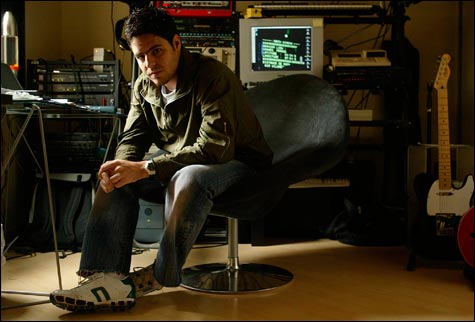
LP-LIKE: It’s not just “for the sake of variety” that there’s variety on Chromophobia.
|
The year being 2007, had I started off telling you this new Gui Boratto album is “intelligent dance music,” you’d have stopped reading right then and there, maybe even logged onto your personal home computer and found a picture of me on-line and shopped some dude’s bird in my mouth. IDM as a term was early-’90s DOA, a nice hook for PR onesheets that soon became anathema. Which is why we have all these people calling themselves “electronic artists,” whatever that means. For all the fantastic music that found itself under its leaky umbrella — Aphex Twin, Boards of Canada, Mouse on Mars, the Warp label’s mostly solid early catalogue — IDM is now a vicious slag, shorthand for boring, hookless abstract beats for the semi-pop turtleneck set.
This is as a good a time as any to mention that I still wear turtlenecks and listen to IDM from time to time, often both at once, but beyond that . . . maybe what I’m trying to say is that I don’t expect full-length dance albums to be front-to-back bangers. Leave that for DJ mixes. So Chromophobia (Kompact) is IDM to my ears because sometimes Gui Boratto takes up electronic dance music’s function (i.e., to induce dancing) and other times he explores the genre’s form (i.e., techno’s traditional rhythms and sounds and textures and ornaments and tempos that combine and recombine to form our favorite tracks). What makes it “intelligent” is that it’s up to the listener to separate form from function. Boratto’s more abstract tracks give breadth and depth and back story to the album’s many floor killers.
I say “techno” because Chromophobia strikes me as very second-wave Detroit, very Jeff Mills, the way the overture of synths in “Scene” cascades in couplets, the way the bass rumbles and rattles across the pan without being too ravy about it. Boratto’s tones are softer on the ear (Mills’s pricked mine into Pong-like paranoia), and his best tracks are just funkier. Highlights include “Shebang,” whose rubber-ball rhythms respond/react until the whole thing switches over to a devastating, monolithic 6/4 shuffle, and the nervous waterdrop hook on “Gate 7,” and “Terminal,” which has this fearless ascending melody that reminds me of Booka Shade’s “Mandarine Girl,” soon slurping its way into another register.
Maybe also it’s just that Boratto makes more pleasant music than Mills, pop songs even; “Beautiful Life” is blissed out in major-key fuzz and served up with one massively silly vocal hook. Still, what I like about my Mills/Boratto comparison is the tug-of-war pacing both artists trade in LP-wise, how introspective moments like the deliberate piano melody of “Mala Strana” and the filter-heavy swirls of “Acrostico” snuggle between stompers without upending cohesion or flow. It’s not just “for the sake of variety” that there’s variety here.
Granted, Chromophobia is no more an IDM disc than any other recent ones that would might also fit my fat bill: Isolee’s Wearemonster, Booka Shade’s Movements, Trentemøller’s The Last Resort, Ricardo Villalobos’s Alchachofa. But my sense is these Real Dance Producers’ dance/not-dance albums are gaining popularity as an Other in the indie-rock crowd: their sound is often very pretty and their rhythms engage in ways that lots of current indie rock is not and does not — to say nothing of most indie-dance remixes and the Franco-filter-metal stuff, which people seem to be figuring out fails as both dance music and indie rock. That’s how IDM functioned the first time round for me at least, as an Other, and an entry way — so let’s spare ourselves the neu-backlash and just listen.